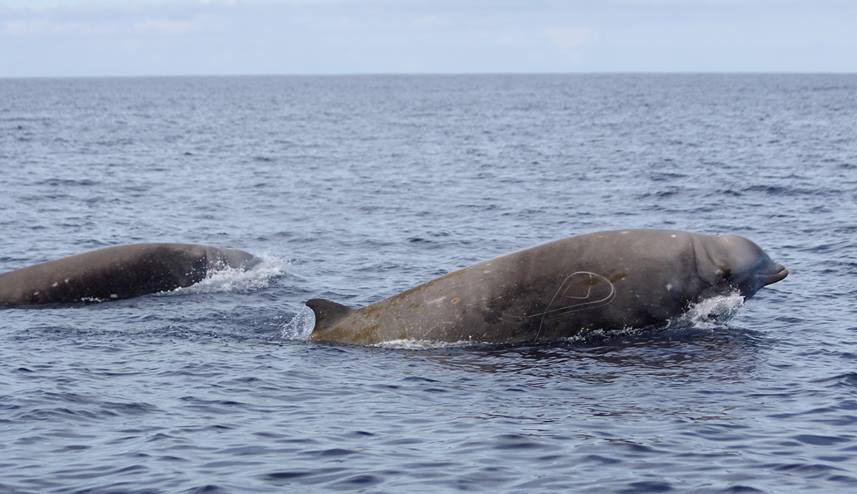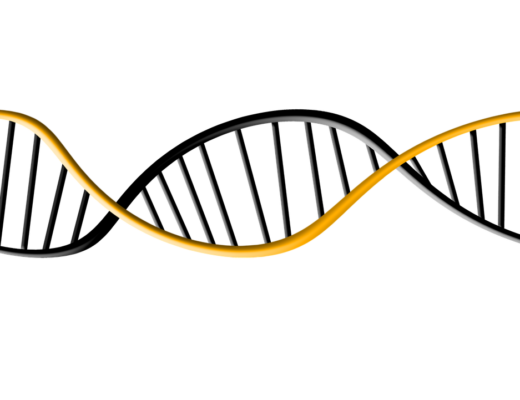Illustration by Alejandra Enriquez
In an empty ocean, even a whale the size of a truck can be prey to vicious predators. So how do these gentle giants avoid getting eaten by predators with sharp hearing and eyesight? New research reveals that beaked whales use a unique silent deep-diving strategy to avoid predation by killer whales.
Despite their huge size, whales are often on the lunch menu of killer whales, also known as orca (Orcinus orca). Killer whales mostly attack whale calves, but they can also gang up and prey on adult whales quite effectively. Whales have evolved sophisticated strategies to escape their large-brained predators. For example, toothed whales, which use whistles and clicks (echolocation) to communicate and forage for food, can tune their vocalisations to beyond the hearing range of killer whales, and some baleen whales can “whisper” to their babies. Many other species, from dolphins to sperm whales, pack together in large groups to protect each other and fight off their predators. Beaked whales, on the other hand, forage alone and communicate with loud clicks, so they can’t use any of these defence tactics.
Beaked whales are medium-size teethed whales with a sort of “beak” (hence their name) and an unusual set of (only) two large tusk-like teeth in males. They regularly dive deeper than 500m to forage for food, but a study reported record-breaking dives nearly 3000m deep and lasting for over two hours!
Although deep diving is common among marine mammals, it’s a very costly behaviour because it uses up a lot of energy which large animals can’t afford to waste. Natacha Aguilar de Soto, Mark Johnson and colleagues at the University of La Laguna, Tenerife (Spain) and University of University of St Andrews, Scotland (UK) suspected that the beaked whales’ deep-diving behaviour could have something to do with avoiding killer whales. Johnson says:
When we see this through the prism that they might be trying to avoid killer whales… it all kind of makes sense.
To test this hypothesis, Aguilar, Johnson and their colleagues tagged Blainville’s (Ziphius cavirostris) and Cuvier’s (Mesoplodon densirostris) beaked whales to track their movement and vocalisations. They had to slowly approach each of the 26 whales on a small boat and then place the tag on their back with a long pole. The tags collected depth and orientation data and recorded sound for about 20 hours.

Previous research reported vey unusual deep-diving behaviours in these whales: they restrict echolocation to the deepest part of their foraging dives and then ascend slowly and silently, in contrast to most whales, which ascend quickly and nearly vertically. Also bizarrely, after these deep dives beaked whales do a series of silent shallower dives.
In the new study, Aguilar’s team found other unique behaviours in Blainville’s and Cuvier’s beaked whales. Unlike other deep-diving whales, beaked whales coordinate with other group members when they dive, but when they reach lower depths, they forage separately using echolocation. As killer whales remain mostly near the surface (max 50m deep), it’s relatively safe to be loud at lower depths.
The researchers also found that after a while hunting for prey, the whales regroup and slowly head on to the surface in silence. They believe that by synchronising their ascent, beaked whales don’t need to talk to each other to regroup- and being quiet is a huge advantage when your predators have a keen sense of hearing.
Even though this tightly synchronized effort cuts out 35% of time spent looking for food, it enables the whales to increase their chances of escaping detection and predation from killer whales.
“The one thing that you would be wanting to do is get back up to the surface quickly” says Johnson, “But they take 20 minutes or so to come back to the surface. So that just doesn’t make sense from the perspective of an animal trying to be efficient and get as much food as possible.” These highly coordinated dives must be explained by the fear of predation.
Social species like sperm whales or pilot whales can take advantage of their sheer size and numbers to fight off killer whale attacks, but beaked whales needed to adopt a different strategy: hiding. Unfortunately, hiding doesn’t save beaked whales from another merciless predator: humans. Beaked whales seem to be extremely sensitive to noise, though exactly why is still not understood. Research shows that most mass strandings occurred after navy exercises with sonars, and there seem to be more beaked whales stranding on the shore of “noisy” seas. The authors suggest that their silent deep-diving hiding strategy makes beaked whales very sensitive to potential threats- it is possible beaked whales perceive naval sonar as the sound of a looming predator, and they somehow become confused or panic and end up losing their way.
What can be done in the future to protect these whales? There is a growing concern that men-made noise is a danger to marine mammals, but it isn’t realistic to say we should eliminate sonar completely. Rather, now that we know how and why these whales are so sensitive to noise, we can avoid using navy sonars in beaked whale habitats. It could be that simple.
Reference:
Image: Cuvier’s whale (female). Credit: J Alcazar, University La Laguna.




